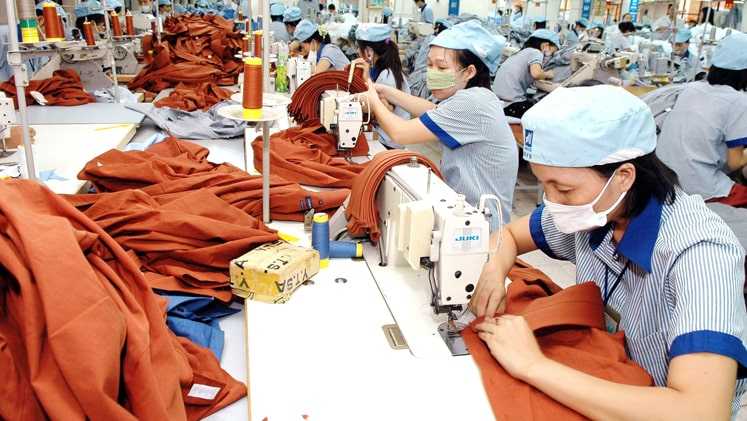
After an impressive export turnover of US $ 36 billion last year, Vietnam’s apparel and textile industry was on a high and with the orders booked till the first quarter of 2019, it wasn’t surprising when industry set a target of US $ 40 billion for 2019.
Much to the expectations, the first 6 months of 2019 saw the apparels and textiles earn export revenue of US $ 17.9 billion. Now that was a jump of 8.6 per cent from what it was during the same period in 2018. Of the export revenue earned, readymade garments touched US $ 14.02 billion (up by 8.71 per cent); fabric touched US $ 1.02 billion (up by 29.9 per cent); and fibre touched US $ 2.01 billion.
However, things haven’t been as good since! There has been a gradual slump in orders and the sad part is that it is now fast moving from small firms to big garment establishments.
Thanh Binh Garment Company is one such firm that witnessed a big cut in orders recently. Worried over this drop, Nguyen Van Nam, Director, of the company said, “My firm has 3 production lines of spandex products with more than 100 workers. However, recently my partner, a local company, unexpectedly cut orders, urging me to seek for new sources with low prices or even without profits to get jobs for my workers.”
This is now the case with most of the bigwigs of the industry, be it Nha Be Corporation, Viet Tien or May 10. What is more worrying is that there are only 3 months to go before the year ends.
Vietnam Textile and Apparel Association (VITAS) is already sceptical of industry achieving the target of US $ 40 billion. And that’s not good news for the industry!
Corroborating on the above, Truong Van Cam, General Secretary, VITAS said, “The number of orders of many apparel and textile enterprises account for just 70 per cent of what it was in the same period last year. This makes it impossible for garment and textile industry to achieve export target of this year.”
So what caused this sudden decline?
VITAS says, the ongoing trade dispute between the two giants has been instrumental in the recession of orders. Notably, the export volume of fibres of Vietnam has been majorly impacted. Earlier, the country produced 2.2 million tonnes of fibre annually (on an average), of which 1.5 million tonnes was for export – 68 per cent of total production.
2019 tells you a different story! The fibre consumption has indeed been challenging this year with the export growing by just 1.1 per cent in the first 6 months. In reality, trade war has not created any opportunity for the industry in Vietnam. The difficult situation of world economy has led to the slump in purchasing power.
Also, while Dong has remained stable, quite a few countries have devaluated their currencies so as to gain an upper hand during export. What it has now done to Vietnam is that the export of Vietnam products has higher cost prices and, yes, this has impacted the garment and textile industry in a big way.
The free trade agreements too don’t seem to have worked wonders! Though they have been signed, they aren’t effective. According to reports, still import duties are imposed on garment and textile products exported from Vietnam, which has forced lot of companies to shift their orders to other nations. With such a plethora of issues, things are just getting tougher for the industry.

But it’s not all that bad! Hope persists…
Yes, there’s been a slump in orders but the total growth rate of apparel and textile sector is still higher than what it was last year. Further substantiating, HCM City Textile and Garment Embroidery Association believes that dearth of orders has happened at only few companies and that too in North Vietnam. The association maintains that things are still much better in HCM City.
Pham Xuan Hong, Chair, HCM City Textile and Garment Embroidery Association says that though local firms are struggling to increase export, foreign companies are increasing exports and could make up for the slump.
If that happens, then the industry might just manage to attain US $ 40 billion.
VITAS believes industry still may need to put efforts to achieve the target. Only if the industry sees a growth rate of 11 to 12 per cent in the coming months, would it be able to reach the projected target. While the small firms should look out to increase exports and ensure high productivity till December, the big ones should share their orders with small firms and keep getting big orders. Mutual understanding could help the industry go a long way in the country.
And, let’s not forget sustainable part of business…
Sustainable business is the magic word these days and local firms need to understand this. Only when these small firms comply with the sustainable requirements of brands and be more transparent, will the brands continue to come to Vietnam.
So, while the industry should invest more on technology and automation, which one is witnessing over the last 2 years, there should be good amount of investment in sustainable practices. VITAS has already joined hands with World Wildlife Fund (WWF) for a three-year project from 2018 to 2020 that aims to transform the country’s apparel and textile industry into ‘green industry’ and thereby bring economic benefits to the country.
At a recent denim conference in HCM City, a lot of denim and industry experts voiced for ‘Green Denim’. The efforts are there, but they are few and far between.
The industry needs to work on these issues not only to achieve the target but also to ensure meeting the big target of US $ 200 billion by 2035.

Post a Comment